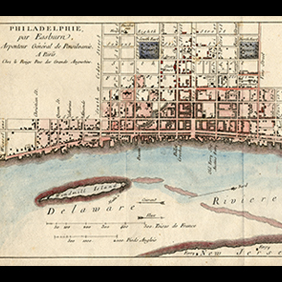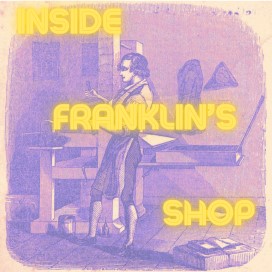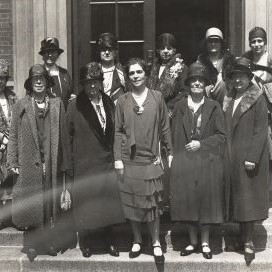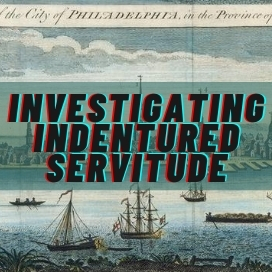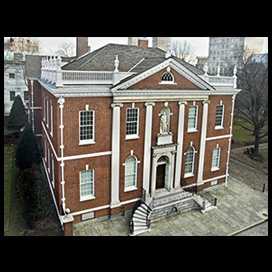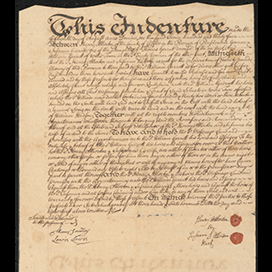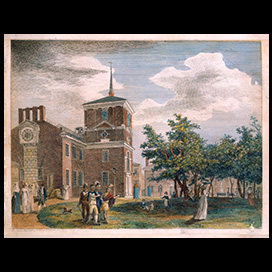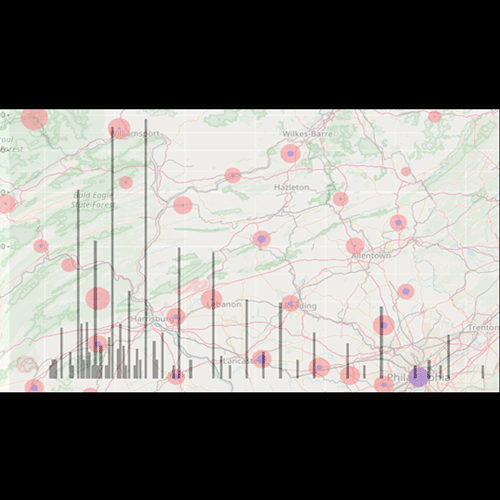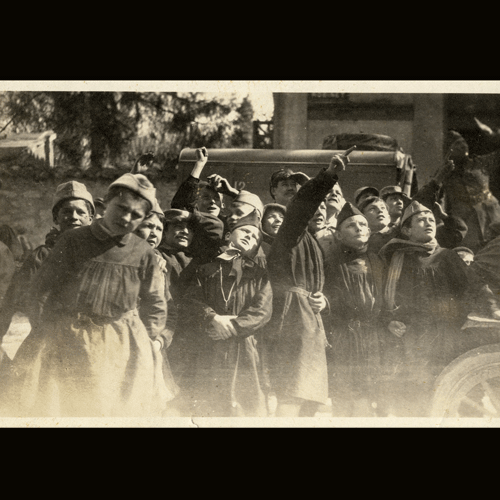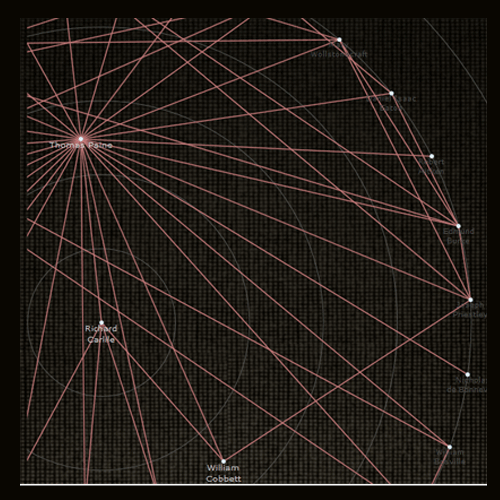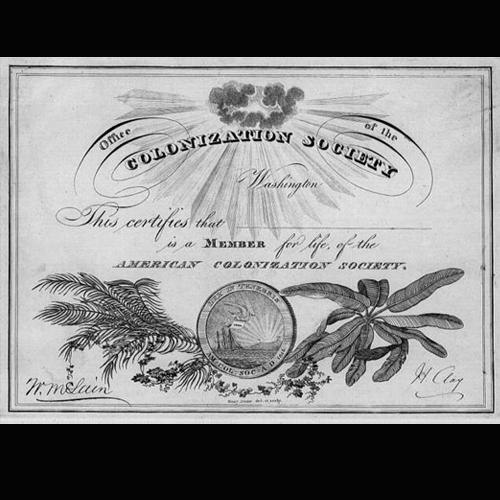The Digital Library Galleries offer a variety of ways to interact with the material in the APS collections. These galleries represent a commitment to work with interns and fellows to develop digital library skills and an interest in library outreach.
Users interested in the galleries may also be interested in exploring the online exhibitions of the APS Library & Museum, available here.
The Revolutionary City: A Portal to the Nation's Founding
The Revolutionary City: A Portal to the Nation's Founding is a one-stop shop for students, teachers, scholars, and lovers of history to learn about diverse stories of the American Revolution from the perspective of early residents of America's revolutionary city.
Credits
This digital portal was created by the American Philosophical Society (APS), the Historical Society of Pennsylvania (HSP), and the Library Company of Philadelphia (LCP) with support from a National Leadership Grant from the Institute of Museum and Library Services (IMLS) and a Sustaining the Humanities through an American Rescue Plan grant from the National Endowment for the Humanities (NEH).
The portal was designed and built using Islandora and Drupal.
View the portal: Revolutionary City: A Portal to the Nation's Founding
Franklins' Philadelphia Ledgers Project
Before he invented the lightning rod, charted the Gulf Stream, or helped to draft the Declaration of Independence, Benjamin Franklin ran a print shop in Philadelphia and also served as Philadelphia's Postmaster General. This gallery is the culmination of a multi-year digital initiative intended to encourage the study of this early stage of Franklin's life and civic engagement by making documentation related to his business affairs with his wife Deborah Read Franklin and his postal administration widely available for the first time, through digitization and release of open historic data as part of the Society's Open Data Initiative.
Credits
This exhibit was written, designed, and built by Cynthia Heider and Bethany Farrell, and edited by Bayard L. Miller and David Ragnar Nelson, using HTML5Up with embedded Tableau Public data visualizations. The Franklin Ledgers Database was prototyped by Cynthia Heider and built by David Ragnar Nelson using Datasette.
View the gallery: Franklins' Philadelphia Ledgers Project
Visualizing Women in Science
The APS Library houses the papers of several famous women scientists, but the achievements of these women sometimes overshadow the labors of countless other women who helped them advance science. In this gallery, we document the names and accomplishments of hundreds of women scientists documented in the APS collections.
Credits
This exhibit was written by Serenity Sutherland and David Ragnar Nelson, with assistance provided by Bayard Miller. Site design was carried out by David Ragnar Nelson. The gallery was built using Jekyll with embedded visualizations designed in D3.js.
View the gallery: Visualizing Women in Science
Investigating Indentured Servitude: Visualizing Experiences of Colonial America
One of the many historical treasures of the APS Library & Museum is a book recording the details of over 5,000 indenture contracts registered between 1771 and 1773. These entries contain a lot of information about working people and immigrants who came to Philadelphia in the lead-up to the American Revolution. This exhibit uses interactive visualizations of data from the book to examine indentured servitude in Colonial British North America through three themes: distance, gender, and time. Included alongside them are personal stories of individuals who entered into contracts in the record to work as servants and apprentices. This exhibit has been created to inspire users to learn more about indentured servitude in the hopes that they will explore the dataset for themselves.
Credits
This exhibit was written, designed, and built by Nicôle Meehan (APS Digital Humanities Fellow), Bayard L. Miller (Head of Digital Scholarship & Technology), and Cynthia Heider (APS Digital Projects Specialist), using HTML5Up with embedded Tableau Public data visualizations. Data refinement was carried out using OpenRefine.
View the gallery: Investigating Indentured Servitude: Visualizing Experiences of Colonial America
In the Heart of Philadelphia: The Story of Library Hall
This gallery invites you to explore the story of Library Hall, showcasing the different phases of its construction and the historical context in which this building came to life.
Credits
This digital exhibit was written by Madalina Veres. The gallery was designed and built by Bayard Miller using HTML5Up. The story map was created by Madalina Veres using StoryMapJS. The project was managed and edited by David J. Gary.
View the gallery: In the Heart of Philadelphia: The Story of Library Hall
Good Deeds in Pennsylvania
In 2014, the American Philosophical Society received a donation of deeds and legal documents recording the ownership of several hundred acres of land in Chester County, Pennsylvania from William Penn's original grant to the 20th century. This unbroken chain of documents archives nearly three centuries of the history of what is now the Brushwood Stable and Bryn Clovis Farm. This gallery offers a guided tour through these complicated documents and views them through the lenses of local, family, and national history.
Credits
This project was written by 2017 APS Elizabeth R. Moran Fellow Alexandra L. Montgomery and Dr. Amanda Charland. The project was managed and edited by David J. Gary.
This gallery was designed and built by Bayard Miller and Scott Ziegler using HTML5Up and StoryMapJS.
View the gallery: Good Deeds in Pennsylvania
Celebrating 275 Years of Promoting Useful Knowledge
To mark the 275th anniversary of the American Philosophical Society in 2018, this timeline highlights key events that helped define the APS during its illustrious history.
Credits
Madalina Veres, Postdoctoral Mellon Fellow in Digital History, researched, wrote, and created the timelines. Bayard Miller built this gallery and served as technical adviser. David Gary provided project management and oversight. Editorial assistance was provided by Elizabeth R. Moran Fellow Julie Fisher. Digitization for the project was done by Joseph DiLullo.
The gallery was built using HTML5Up and TimelineJS..
View the gallery: The American Philosophical Society: Celebrating 275 Years of Promoting Useful Knowledge
Americanization: Then and Now
How have the politics and rhetoric of U.S. immigration policy shifted over the past century?
This gallery explores a 1919 immigration pamphlet that contains rhetorical features that might surprise contemporary readers.
Credits
This digital gallery was designed and built by Bayard L. Miller and Scott Ziegler for the Center for Digital Scholarship. Will Fenton, 2018 APS Elizabeth R. Moran Fellow, conceived of the project and wrote the text for the gallery. Adrienne Winans, Assistant Professor of History at Utah Valley University, served as the project's historical advisor.
The gallery was built using HTML5Up.
View the gallery: Americanization: Then and Now
Eastern Apps: Visualizing Historic Prison Data
The APS Library holds admission books of the Eastern State Penitentiary, from roughly 1830-1850. The admission books contain the names, offences, sentences, places of origin, and race/ethnicity of inmates, as well as comments about the moral standing of the prisoners.
This gallery presents a collection of interactive apps that explore trends in the data from the books.
Credits
Steve Marti, 2017 APS Library Digital Humanities Fellow, created the Eastern Apps. Scott Ziegler, Head of Technology and Digital Scholarship, initiated and managed the project in conjunction with Bayard Miller, Digital Projects and Metadata Librarian. Special thanks to Robert M. Hauser for assistance with the visualizations.
The apps were built with Shiny from R Studio. The gallery was built using with HTML5Up.
View the gallery: Eastern Apps: Visualizing Historic Prison Data
A Journey of Inquiry: Exploring the Scientific Process
Baruch S. Blumberg led a varied life full of unexpected adventure and discovery.
This gallery highlights the influence of the philosophy of science that coursed through his scientific career.
Credits
Written, designed and built by Andrew Lippert with assistance from Bayard Miller, using HTML5Up.
View the gallery: A Journey of Inquiry: Exploring the Scientific Process
Frontiers of Knowledge: Britton Chance and New Channels of Discovery
From his earliest days as an inventor to his days as a pioneer of biophysics, Britton Chance was dedicated to scientific research and medicine, with patents in fields ranging from seafaring devices to magnetic imaging.
This gallery highlights different periods of Britton Chance's life and career through photographs, letters, and other documents.
Credits
Written, designed and built by Bayard Miller and Scott Ziegler, using HTML5Up and TimelineJS. The Britton Chance papers were processed with the generous support of the Arnold and Mabel Beckman Foundation.
View the gallery: Frontiers of Knowledge: Britton Chance and New Channels of Discovery
Too Near to Where History is Being Made: Henry Howard Houston II In a Time of War
This gallery follows the life of Henry Howard Houston II, a young Philadelphian who fought and died in World War I.
The day he graduated from the University of Pennsylvania, Henry joined the Pennsylvania National Guard to serve at the U.S.-Mexican border during the U.S. punitive expedition against Pancho Villa in 1916.
After leaving the border, he joined the Ambulance Corps in France. When the U.S. officially joined the war, Henry returned to America and trained with the U.S. Army. He returned to France as an aerial observation officer. He died in France in 1918.
The gallery is divided into four sections. The first uses a map to join together letters and pictures from Henry's journey around the country and to France. The second highlights photographs from the collection. Many of these show the devastation of war. The final sections surface themes and topics that are found in Henry's letters. These sections provide an entry into the world in which Henry lived and the issues that we important to him.
Credits
Intern: Robert Teel
Technologies: StoryMap JS, HTML5Up
View the gallery: Too Near Where History is Being Made
Joining the Fray: Mapping a World of Paine
This graph contextualizes a selection of digitized cartoons, portraits and broadsides from the Colonel Richard Gimbel Collection of Thomas Paine Papers.
The reception, reputation and reactions to Paine are charted in Joining the Fray: Mapping a World of Paine. Particular attention is paid to the printers and publishers who often risked their safety to make these works available, as well as the members of extra-parliamentary associations demanding reform in the age of Paine.
All digitized graphic material related to Thomas Paine can be seen here and all text material from that same collection can be found here.
Credits
Intern: Alina Josan, Spring 2015
Technologies: JavaScript InfoVis Toolkit
View the gallery Joining the Fray: Mapping a World of Paine.
Colonization in the Foulke Papers
While Pennsylvania slaveholders gradually relinquished their title and freed their slaves, the fate of the millions of slaves still held in bondage across the United States became a topic of heavy political debate.
Enhancing the work of the African American Subject Guide, this gallery includes example letters from the correspondence, short biographical sketches of the individuals involved and a bibliography of relevant sources. Scholars interested in the colonization movements of the Nineteenth Century are encouraged to use this gallery as a starting point into these matters.
Credits
Intern: Stephanie Lampkin, Summer 2014
Technologies: Drupal, Islandora, TimelineJS

